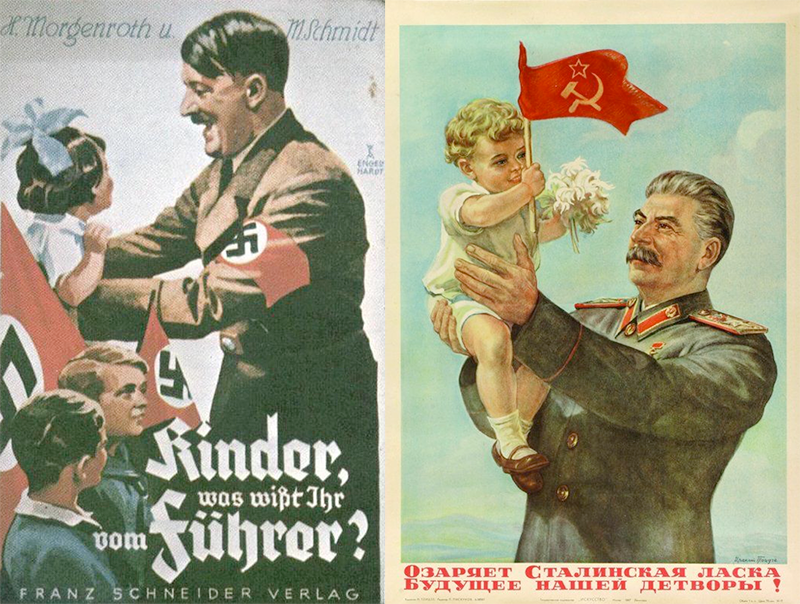
Hitler killed millions and Stalin killed millions more. Who killed the most human beings is frequently debated, yet the exact numbers are so inconceivable, does two or three million more or less make a difference? It does to those who died. But, without trivializing mass murder, it also raises some perplexing brand questions about why the Nazi swastika is universally reviled as the logo of terror and genocide while the Soviet hammer and sickle has not been similarly stigmatized. Why is one the symbol of hate while the other is virtually benign? This question has troubled me since I began studying the graphic design and branding of these two dictatorships and the signs and symbols inspired by their ideological dogma.
Arguably, the hammer and sickle has negative connotations for many people, but it was never officially outlawed as was the swastika in postwar Germany. Nor is the hammer and sickle scrawled on synagogues, grave stones, or tattooed on white supremacists as are swastikas.
Perhaps this is a kind of Darwinian survival of the fittest brand strategy. In truth, both represent state sanctioned homicide and terror. Stalinism was every bit as brutal as Nazism, if not more so. But the Nazis lost and the Soviets won the “Heroic War.” Although Stalin imprisoned and executed millions of Russians, Ukrainians, Poles, and others within his borders during induced famines and Great Purges, the spoils of his unconditional victory in World War II included a free ride until 1956, three years after his death, when Nikita Khrushchev, First Secretary of the party, denounced Stalin’s crimes and his cult of personality. Yet while Stalin was branded the villain, the hammer and sickle remained the national symbol until the Soviet Union was dissolved in 1991 and the hammer and sickle flag was lowered for the last time over the Kremlin, replaced by the Russian tricolor.
Logos are not entirely judged by design but rather what the design represents. If mass murder is the measure of that representation, then both these symbols should be forever condemned. For that matter, other nations that have engaged in heinous acts should likewise have tainted or banned symbols. But none in the entire world — not even ISIS — equal the malevolence ascribed to the swastika. None send the shivers of fear and revulsion as does the swastika.
Both the swastika and the hammer and sickle were initially benign symbols. The swastika has a much lengthier history of positive connotations for many peoples and religions — good luck, fertility — until it was adopted by occult racialist cults in late nineteenth century Germany. The more modern hammer and sickle aptly represented the unity of worker and peasant — the rise of the proletariat.
For all intents, both were politicized as signs of upheaval. A war of signs pitted each against the other during the fractious post-World War I violence between Nazis and Communists in Weimar Germany. Both logos were more than mere identifiers, they were weapons. Their respective brand extensions — on the Nazi side ominous runic symbols used by different Hitlerian organizations (then and now) and on the Soviet side, the red star, and portraits of Lenin and Stalin.
The Nazis used the swastika as efficiently as the Soviets used their own emblem. Both were simple, stark, and impressive. On balance, to equate it to competing products, they are ostensibly the same product with slightly different ingredients, but the brand story for the Nazis has, throughout history developed extremely more negative facts, even though the expanding number horrifying memoirs, biographies, and histories of Stalin’s “Great Terror” are no less nauseating and mind boggling. Still, the swastika conjures images of the worst of humankind, while the hammer and sickle speaks of a tragic (albeit longer) period in world history.
Admittedly, this entire comparison may be criticized as inconsequential and yet think of how white power racism would look if the swastika were swapped with the hammer and sickle. It is simply not the same (nor would it happen). Ironically, the swastika represents white supremacy and anticommunism while the hammer and sickle had strategically feigned sympathy with and support for oppressed peoples of color in order to spread third world revolutions. Maybe that is the strategic sweet spot of Soviet branding that prevented the hammer and sickle from becoming vilified.
